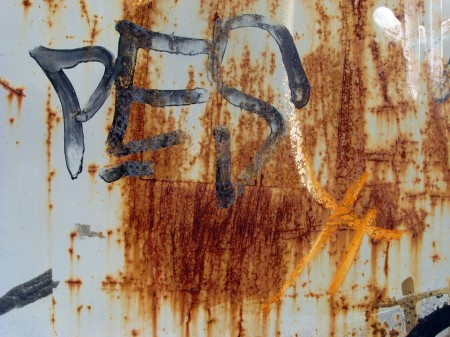The oddest thing I learned from Wikipedia recently is that when snails mate, they attempt to shoot one another in the head with a calcium ‘love dart.’ Snails are hermaphroditic, exchanging sperm with one another and later using it to fertilize their own eggs. In Helix aspersa, the darts are coated with chemicals that cause the ducts in the other snail to contract, possibly suppressing the function of sperm-digesting enzymes.
The whole process sounds rather perilous:
The darting can sometimes be so forceful that the dart ends up buried in the internal organs. Sometimes the darts pierce the body or head entirely, and protrude on the other side…
The dart is shot with some variation in force, and with considerable inaccuracy, such that one-third of the darts that are fired in Helix aspersa either fail to penetrate the skin, or miss the target altogether.
A photo accompanying the article shows edible snails (Helix pomatia) engaging in weird but surprisingly photogenic mollusc courtship.


They who one another keep
Alive, ne’er parted be.
(excluded verse: until they have finished shooting paralyzing darts into one another and move on to fertilize their own ovum.)
.. Donne, secretly, always wrote about the love-making of molluscs.
Problem: You want to get as much of your sperm as possible to fertilize the eggs of a fellow hermaphroditic snail, but he/she digests a lot of it.
Solution: You shoot the other snail in the head with a dart covered in digestion-suppressing chemicals.
Ah, the gentle beauty of nature.
Dr. Tatiana’s Sex Advice to All Creation: The Definitive Guide to the Evolutionary Biology of Sex
Finally, a how-to guide, in the guise of a Q&A advice column, for marching, flying, or slithering into the battle of the sexes, whatever your species. In this entertaining and informative book, evolutionary biologist Olivia Judson presents “letters” from sexually frustrated animals, birds, and insects who ask “Dr. Tatiana” to explain some sexual oddity. For example, “Don’t Wanna Be Butch in Botswana” writes, “I’m a spotted hyena, a girl. The only trouble is, I’ve got a large phallus. I can’t help feeling that this is unladylike. What’s wrong with me?” Each question leads Dr. T. into a fascinating explanation about the sex life of this species, sprinkled with sprightly stories about other species with similar attributes or behavior.
You’ll learn why one stick-insect copulation lasts for 10 weeks (to prevent other males from gaining access to the fertile female) and why the black-winged damselfly’s penis has bristles (to scrape out his rival’s sperm). You’ll learn that male and female orangutans masturbate with sex toys fashioned from leaves and twigs, that slugs are hermaphrodites with penises on their heads, and that females in more than 80 species eat their lovers before, during, or after sex. You’ll also ponder human sexuality when you learn that “monogamy is one of the most deviant behaviors in biology” (although jackdaws, chinstrap penguins, California mice, and some termites swear by it) and “natural selection, it seems, often smiles on strumpets.”
Highly recommended–you’ll read this through just for the fun of it and have plenty of odd facts with which to dazzle your dinner companions. –Joan Price
I will be thinking of this next time I order escargot.